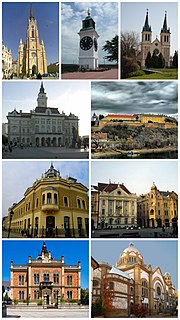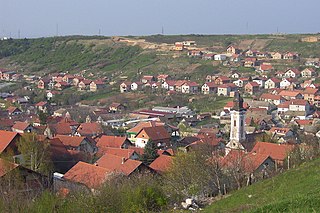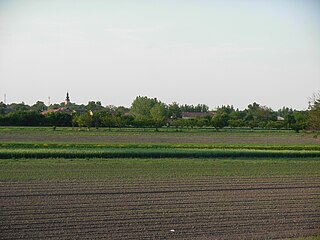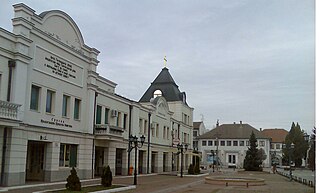
Sremski Karlovci is a town and municipality located in the South Bačka District of the autonomous province of Vojvodina, Serbia. It is situated on the banks of the Danube, 8 kilometres from Novi Sad. According to the 2011 census results, it has a population of 8,750 inhabitants. The town has traditionally been known as the seat of the Serbian Orthodox Church in the Habsburg Monarchy. It was the political and cultural capital of Serbian Vojvodina after the May Assembly and during the Revolution in 1848.

Novi Sad is the second largest city in Serbia and the capital of the autonomous province of Vojvodina. It is located in the southern portion of the Pannonian Plain on the border of the Bačka and Syrmia geographical regions. Lying on the banks of the Danube river, the city faces the northern slopes of Fruška Gora.

Petrovaradin is a historic town in the Serbian province of Vojvodina, now a part of the city of Novi Sad. As of 2011, the urban area has 14,810 inhabitants. Lying on the right bank of the Danube, across from the main part of Novi Sad, it is built around the Petrovaradin Fortress, historical anchor of the modern city.

Sremska Kamenica is a town and urban neighborhood of Novi Sad, in Serbia.

Bistrica, also known as Novo Naselje, is an urban neighborhood of the city of Novi Sad, Serbia.

Telep is an urban neighborhood of the city of Novi Sad, Serbia.

Stari grad is an urban neighborhood of the city of Novi Sad, Serbia. It is the main part of Novi Sad, and it is also known as City Centre. In the Serbian language, the name "Stari grad" means "Old Town".

Bukovac is a suburban settlement of the city of Novi Sad, Serbia. It is located in Petrovaradin municipality. The village has a Serb ethnic majority and its population is 3,936.

Begeč is a suburban settlement of the city of Novi Sad, Serbia. It is situated on the river Danube, approximately 15 km west from Novi Sad, on Bačka Palanka-Novi Sad road. According to 2011 census, the village has a Serb ethnic majority and its population numbers 3,325 people.

Kać is a suburban settlement of the city of Novi Sad, Serbia. The town has a Serb ethnic majority and its population was 11,612 at the 2011 census.

Rumenka is a suburban settlement of the city of Novi Sad, Serbia. The village has a Serb ethnic majority and a population of 20,000 people.

Rotkvarija, also known as Žitni Trg, is an urban neighborhood of the city of Novi Sad, Serbia.

Podbara is an urban neighborhood of the city of Novi Sad, Serbia.

Slana Bara is an urban neighborhood of the city of Novi Sad, Serbia.
Almaš was an ethnic Serb village in Bačka. It existed until the first half of the 18th century. The village was located on Almaška bara, between Temerin, Nadalj, and Gospođinci.

This is a list of the neighbourhoods and suburbs of Novi Sad.

Religious architecture in Novi Sad is very diverse. Majority of the believers in Novi Sad are from Serbian Orthodox Church, while others are from Roman Catholic Church, many Protestant churches, and Jewish community. Stari Grad is the place with the majority of churches and temples, and they were all built in the 18th and 19th century.

Novi Sad is the second largest city of Serbia. It began as a Stone Age settlement in present-day Petrovaradin. The Celts founded the first fortress at this location. During Roman rule, a larger fortress was built in the 1st century AD. It was devastated by the Huns in the 5th century and rebuilt by the Byzantines. The city passed through many other hands until being conquered by the Kingdom of Hungary. The city was first mentioned under the name Peturwarad or Petrovaradin in documents from 1237. It passed through the Ottoman Empire in the 16th century and the Habsburg Monarchy in the 17th.

The Cathedral Church of the Holy Great-Martyr George is the seat of the Serbian Orthodox Eparchy of Bačka, located in Novi Sad, northern Serbia. The present-day church was completed in 1905, on the ruins of a church built in 1734 and destroyed in 1849. It is located next to the Eparchy offices in the Bishop's Palace, in Nikola Pašić Street. It is commonly known as Saborna crkva among the city residents.
Pavle Simić was one of the most significant artists during the Serbian Romantic era.





















